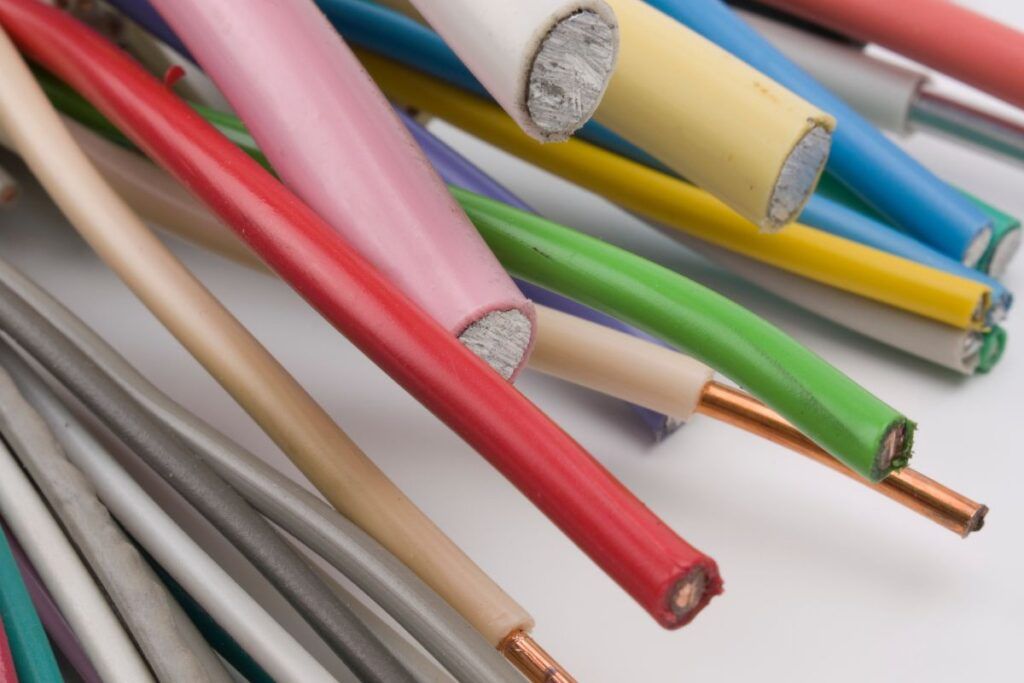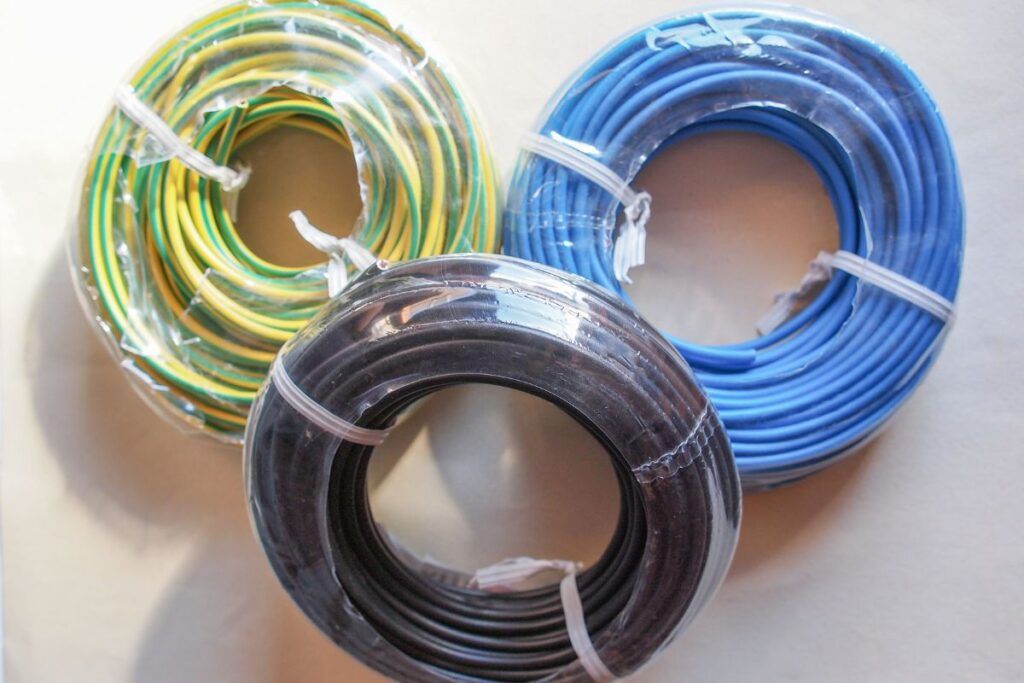To understand the appropriate usage of wires, learning their varying gauge sizes is crucial. Typically, wires with lower gauge numbers are thicker. Therefore, a 12-gauge wire is preferable over a 14-gauge wire.
The primary difference between a 12 and 14-gauge wire is the thickness. A 12-gauge wire’s diameter is 2.055 mm, whereas a 14-gauge wire is 1.63 mm. That is why a 12 AWG is stronger and heavier than a 14 AWG. A 20-Amp circuit requires a 12-gauge wire, whereas a 15-Amp needs a 14-gauge wire.
Sometimes, the wires are often labeled as 12 or 14-gauge. But you need to know the right one. So, this article will clarify the primary differences between the two wire gauges to help you know the right one and use them in the right place.

Check out our list of top-handpicked products for all your electrical, appliance, and HVAC system needs to keep your home running smoothly.
This post includes some affiliate links.How do I tell if the wire is a 12 or 14-gauge wire?
If you are new to wiring, it isn’t easy to understand the right gauge size of the wires.
Since the sizes 12 and 14 are quite close, people may assume that there is not much difference between the two.
As a result, they use the wrong wire for the wrong purpose.
So, you should know the difference between the two wire gauges to determine the right size.
Below are some points which will help you know if the wire is a 12 gauge or a 14 gauge and distinguish between the two.
Wire thickness
The first and foremost step to understanding whether a wire is 12 or 14 gauge you need to determine the thickness of the wire.
The thickness of the 12-gauge wire is 2.05-2.75 mm, whereas the thickness of the 14-gauge wire is 1.63-1.99 mm.
So, it is clear that the 12-gauge wire is quite thicker than the 14-gauge wire.
There is a huge difference between the two.
So, do not ever consider both wires to be similar.
The thickness of the 12-gauge wire is 26% more than the 14-gauge wire.
It also contains a 56% larger cross-sectional area than the 12-gauge wire.
In a gauge wire measurement, the gauge number will decrease when the size increases.
So, the bigger the size, the better the wire.
Do not get confused with the numbers.
Wire strength
Since the size and diameter of the 12-gauge wire is much higher than the 14-gauge wire, the former has more strength than the latter.
The 12-gauge wire has more conductivity and durability than the 14-gauge wire.
Since the 14-gauge wire is thinner, it will have less conductivity and durability.
Generally, the strength of the wire is somewhat related to the thickness.
Since the 12-gauge wire thickness is more, the strength is higher.
Since the 12-gauge wire is stronger, it will prevent electricity loss, overheating, and damage to the electrical circuits.
Wire weight
Thickness is related to every other point.
The 12-gauge wire is thicker than the 14-gauge wire.
So, the 12-gauge wire will bear more weight than the 14-gauge wire.
Due to the higher thickness, the 12-gauge wire will carry more mass than the 14-gauge wire.
The higher the mass, the more the weight.
You can tell which gauge wire is 12 and 14 by lifting and weighing them.
Besides, you should know that the higher the gauge number, the lighter the wire will be.
Since the 14-gauge wires are a higher number than 12, they will be lighter than the 12-gauge wire.
If you ever measure the two wires, you will notice that the 12-gauge wire is 40% heavier than the 14-gauge wire.
Which wire gauge is cheaper?
The cost of the wire gauges is another way of differentiating the two wires.
The bigger the wire, the higher the price.
The 12-gauge wires are bigger, thicker, heavier, and much better than the 14-gauge wires.
So, the 12-gauge wires are more expensive than the 14-gauge wires.
The 12-gauge wires also carry huge current loads of 20 amperes. So, that is why they are costly.
Though the 12-gauge wires are a high-quality wire and the best option for a 20 amp circuit, you can opt for something cheaper if you cannot afford them.
However, there are risks to using high-numbered gauges.
For example, a lamp will blow up using a 14-gauge wire.
You can change the wire material according to your affordability.
Copper wires are quite expensive compared to aluminum and copper-clad aluminum wires.
You can use 14 gauge wires for your house wiring.
But it is always better to go for the best one, which is a 12 gauge wire.
Which wire should I use for the lights?
The 12-gauge wires are the best choice if you have a circuit with lights.
Due to the weight and thickness, the 12-gauge wires are not as flexible as the 14-gauge wires.
But a 12-gauge wire on a 15 or 20-amp circuit is safer than the 14-gauge wire.
If you want to use 14 gauge wires, it can only carry a limited load of 15 amps.
A 12-gauge wire is better for lights since it has less resistance due to its thickness and large size.
Besides, 12-gauge wires can carry more current loads than 14-gauge wires without overheating.
So, if you use 12 gauge wires for lights, there will be fewer chances of flickering.
Which one should I use?
Both wires have their purposes.
Just because a 12-gauge wire is stronger and handles more current, it doesn’t mean that the14 gauge wires are worthless.
Both have advantages, but it is always better to use 12-gauge wires since they have more benefits than 14-gauge wires.
The type of wire gauge depends on which device you want to use and for what purpose.
If you have a circuit of 15 amps or within it, then you can go for the 14-gauge wires.
But, it is better to use 12 gauge wires if you have 20 amps.
A 14-gauge wire is thinner and, thus, cannot carry huge current loads.
So, using them for heavy appliances or lights with a current load of more than 15 amps.
The appliances and lights may get overheated and catch fire if the current load exceeds 15 amps.
What happens if I use 14 gauge wire in a 20 amp circuit?

Using a 14-gauge wire in a 20-amp circuit is not recommended.
If you have 20 amp circuits, use the 12-gauge wires.
If you forcefully use 14 gauge wires in a 20 amp circuit, the outlets will not perform well.
They may also set electrical fires due to overloading.
The current will overflow, melt the wire and circuit, and cause a fire hazard.
A 14-gauge wire is designed for a 15-amp circuit only.
Outlets for the wire gauges
14 gauge wire
In general, you can use 14 gauge wires for a 15 amp circuit and within it.
Amperages of more than 15 can overload the wire.
According to the NEC (National Electric Code), a 15 amp circuit can draw only a 12 amp current.
In that sense, you can use only 8 outlets on a 14-gauge wire.
However, there is no specific information about the number of outlets to be put in a 15-amp circuit.
But eight is a standard number. Using more than eight can overload the circuit and trip it off.
12 gauge wire
If you have a 20 amp circuit, you are allowed to put 12 gauge wires in this circuit. A 20-amp circuit is allowed to draw 16 amps.
In that sense, you can use only 10 outlets in the circuit.
As mentioned earlier too, there is no specific number mentioned anywhere.
But, adding 10 outlets in a 20 amp circuit and using a 12-gauge wire is the right thing to do.
Uses of the wires
Though 12-gauge wire is better than 14-gauge wire, you can use both in different circumstances.
12 gauge wire
There is no specific usage of 12 gauge wire anywhere.
However, they are good for kitchens, bathrooms, outdoor receptacles, and 120V air conditioners supporting 20 amps.
Depending on the height, you can use a 12-gauge wire up to 70 feet on a 15-amp circuit.
On a 20 amp circuit, you can use up to 50 feet only.
The higher the amp, the lower the height.
14 gauge wire
A 14 gauge copper wire is ideal for lights, fixtures, and lighting circuits connected to a 15 amp circuit.
It would be best to use wires depending on the number of outlets added to the circuit.
A 14-gauge wire is not very flexible. So, it may be difficult for the wire to hold heavy equipment for a long time.
Besides, a 14 gauge copper wire will measure around 1.63 mm, which means high resistance and overheating due to more current flow.
Common wire gauges

Wire gauges come in different numbers and sizes.
Different wires are used for different purposes, depending on how much current is flown.
Some common wire gauges are:
- 14 gauge wire
- 12 gauge wire
- 10 gauge wire
- 8 gauge wire
- 6 gauge wire
- 2 gauge wire
There are some other gauges too.
And as I said, different gauges have different usages.
Below are some wire gauges and the right amperage for them:
- 18-gauge wire for low voltage lights and lamp cords in the 10 amps
- 16-gauge wire for light-duty extension cords in a 13 amp
- 14-gauge wire for light fixtures, lamps, and light circuits in 15 amps
- 12-gauge wire for kitchen, bathroom, outdoor outlet, and 120V air conditioners in 20 amps
- 10-gauge wire for electric cloth dryers, 240V window air conditioners, and electric water heaters in 30 amps
- 6 gauge wire for cooktops and ranges having 40-50 amp circuits.
- 4 gauge wires for electric furnaces and large electric heaters carrying 60 amps.
Final thoughts
The easiest way to identify a 12-gauge wire and a 14-gauge wire is by thickness.
The 12-gauge wire measures 2.05 mm, whereas the 14-gauge wire measures 1.63 mm. So, the 12-gauge wires are quite thicker than the 14-gauge wires.
You can also feel the difference by weighing the wires. Since the 12-gauge wires are thicker, they have more mass and weigh more than the 14-gauge wires.
The 12-gauge wires are stronger compared to the 14-gauge wires.
So, these are the common ways to learn if the wire is 12 gauge or 14 gauge.
The 12-gauge wires can be used in 20 amp circuits. But you should not use 14 gauge wires higher than 15 amp circuits.
Though both wires have their purposes and benefits, 12-gauge wires are considered the best.
Data Source: National Electrical Code, Electrical wiring, Home wiring.

